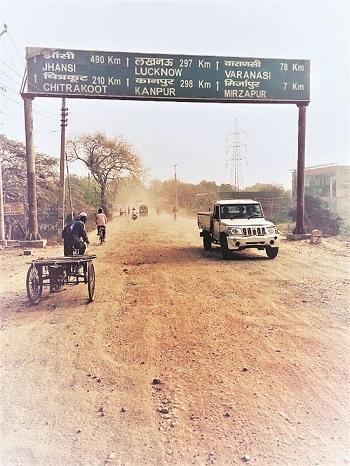It bears the dusty, musty air of a mofussil town where quality of life has deteriorated over the years. Uttar Pradesh (UP) Chief Minister Akhilesh Yadav said during electioneering that if Prime Minister (PM) Narendra Modi were to drive down the Yamuna Expressway, he’d be impressed enough to cast his own vote for Samajwadi Party (SP). Meanwhile, Mirzapur locals joke bleakly that if Yadav were to cycle down a small stretch of the town’s bumpy, broken roads, even he won’t vote for himself! Indeed, with its bad roads, patchy power supply and poor social infrastructure, Mirzapur bears little evidence of being the centre of the hand-knotted carpet and dhurry industry, which has 860 exporters with an annual turnover of over Rs 5,000 crore and employs 1.5 million regular, and one million unorganised artisans. In the week before Mirzapur and adjoining Assembly constituencies go to polls on Wednesday in the seventh phase of UP elections, embittered locals in its crumbling bazaars say perhaps it would be better if they were vidhayak vimukt, MLA-free.
Consider these facts: Last year’s rains have washed away most of Mirzapur’s internal roads, while the National Highway 7 that girds the town, has been broken and under repair for almost one year. The town’s only connection to GT road via Aurai has been broken down and dug up for even longer. A bridge being built by Uttar Pradesh State Bridge Corporation Limited on Bhatauli Ghat that would reduce the time from Varanasi to Mirzapur by half, has been under construction since 2006.
Consequently, many of Mirzapur’s carpet and dhurry businesses are floundering. Siddh Nath Singh, vice-chairman of Carpet Export Promotion Council, reckons that as many as 30 per cent of exporters have either reduced their business, or shut down in the past five years. The need of the hour, he says, is tax breaks and financial support from the Centre and state, and an institute which imparts cutting edge training different aspects of carpet making. “The industry needs this to become competitive in international markets,” he says. The sole voice of the carpet industry in the political arena is Bahujan Samaj Party’s Parvez Khan of Neman Carpets. He proposes to focus on providing housing, potable water, road development and the development of the carpet industry — the region’s largest employer. “It’s getting increasingly harder for people like me to do business here,” he says. “Things have to change.”
However, as political campaigns reach fever pitch in Mirzapur, other candidates seem oblivious in the carpet industry’s problems. In his well-attended March 3 rally in Mirzapur, the PM promised to waive off farmer loans and develop tourism in the region, but said little about the carpet industry. “He’s concerned about Varanasi’s handloom industry,” says Singh, “what about the carpet industry next door?” Meanwhile, Ratnakar Mishra, the BJP candidate from Mirzapur and a priest in the famous Vindhyachal Temple proposes to develop tourism in a town where hardly any hotels have come up in the last five years; public transport consists of cycle rickshaws and the drive to Varanasi and Allahabad (the nearest air and railheads) is, as already mentioned, backbreaking. Suchismita Maurya, BJP candidate from Majhwan echoes party’s attempt to woo the rural voter by promising to repair an old canal to reduce the farmers’ dependence on rain-fed agriculture.
SP, with its focus on business and development, also seems off-target in Mirzapur. “If Yadav talks about his government’s achievements in highway construction here, he’ll be lynched!,” says a pan-seller who lost business because the dust from the broken road renders his betel leaves inedible. Twenty-nine-year-old Rohit Shukla, SP’s candidate from adjoining Majhwan constituency, says locals perhaps don’t realise that the biggest offender is the National Highway Seven, which has been undergoing painfully slow repairs for the last year over which the state government has little control.

With bad roads and patchy power supply, Mirzapur bears little evidence of being the centre of UP’s hand-knotted carpet and dhurry industry. Photo: Geetanjali Krishna
